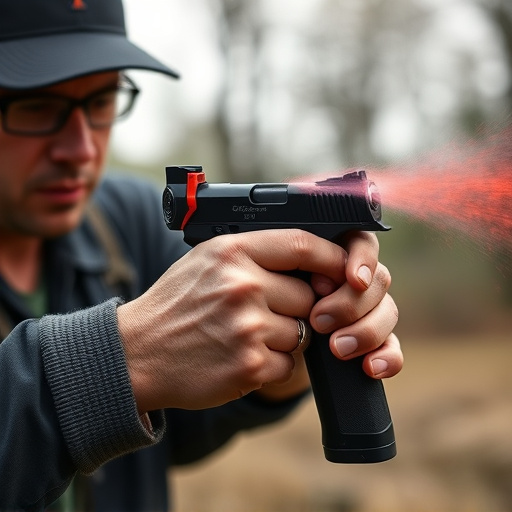The article discusses the best pepper spray self-defense techniques, highlighting the importance of understanding the spray's range (2-3 meters) and duration for effective crowd management. It emphasizes aiming for sensitive areas like eyes, nose, and mouth to quickly disable an assailant. Techniques such as the "stun and run" method are recommended, along with proper training to ensure safe and responsible use, minimizing accidental discharge while empowering individuals to defend themselves legally. Riot control agents are governed by diverse global legal frameworks, emphasizing tactical decision-making and de-escalation for responsible crowd control.
Riot control agents, including pepper spray, have become integral tools in law enforcement’s arsenal, offering a range of options for managing civil unrest. This article explores the world of these powerful substances, delving into their types, effectiveness, and global legal frameworks. We’ll uncover the intricacies of pepper spray as a legitimate self-defense mechanism, highlighting best practices to ensure safe and effective use. Discover the varying perspectives on legislation and training worldwide, focusing on the critical balance between public safety and individual rights, especially when it comes to mastering the best pepper spray self-defense techniques.
- Understanding Riot Control Agents: Types and Their Effectiveness
- Pepper Spray as a Legal Self-Defense Mechanism
- Best Practices for Safe and Effective Use of Pepper Spray
- Global Perspectives on Riot Control Agent Legislation and Training
Understanding Riot Control Agents: Types and Their Effectiveness
Riot control agents, often referred to as chemical or pepper spray, are powerful tools utilized by law enforcement agencies for crowd management and self-defense during high-risk situations. These agents work by causing a range of physiological effects, primarily irritation and temporary incapacitation. The most common types include oleoresin capsaicin (OC), which is derived from chili peppers, and newer formulations like 1,300-1,500 SCU (spray concentration units).
When it comes to self-defense, the best pepper spray techniques involve understanding its range and duration. Typically, a good spray should have a reach of around 2-3 meters, allowing users to maintain distance from potential threats. Effective spraying involves aiming for the eyes, nose, and mouth—sensitive areas that can quickly disable an assailant. Practicing proper application techniques, such as the “stun and run” method, where one sprays and then retreats, is crucial for maximizing safety and minimizing exposure.
Pepper Spray as a Legal Self-Defense Mechanism
Pepper spray, a popular and powerful riot control agent, has evolved from its law enforcement use to become a viable option for personal self-defense. In many jurisdictions, citizens are legally permitted to carry pepper spray as a means of protecting themselves against potential threats. This legal framework recognizes the effectiveness of pepper spray in deterring and neutralizing attackers, providing individuals with an essential tool for personal safety.
The best pepper spray self-defense techniques involve understanding its range, duration, and safe application. Users should practice aiming for the eyes and face, as this area is most sensitive to capsaicin, the active ingredient in pepper spray. Proper training ensures that individuals can deploy the spray effectively while minimizing the risk of accidental discharge or collateral damage. With proper knowledge and responsible use, pepper spray empowers individuals to defend themselves in various situations, making it a valuable addition to personal safety strategies.
Best Practices for Safe and Effective Use of Pepper Spray
The safe and effective use of pepper spray, also known as oleoresin capsicum (OC) spray, requires a combination of training and best practices. Law enforcement agencies and individuals engaged in self-defense should prioritize understanding the mechanics of the spray, including its range, effectiveness, and deactivation processes. Proper training ensures users know how to aim for high-risk areas like eyes, nose, and mouth, maximizing impact while minimizing collateral damage.
Best pepper spray self-defense techniques include keeping a safe distance, around 2-3 meters, to avoid wind blowing the spray back towards the user. Regular maintenance of the spray device is crucial; checking expiration dates and ensuring proper storage conditions preserve its potency. Additionally, knowing local laws and regulations regarding pepper spray ownership and use is essential to avoid legal repercussions while maintaining personal safety.
Global Perspectives on Riot Control Agent Legislation and Training
Riot control agents, often associated with law enforcement strategies for crowd management, are governed by varying legal frameworks globally. Many countries have stringent regulations in place to ensure responsible usage and strict controls on manufacturing, storage, and distribution. These laws vary significantly from nation to nation, reflecting diverse cultural perspectives on public order and individual rights. For instance, some jurisdictions have comprehensive legislation that includes detailed specifications for the types of agents permitted, their concentrations, and approved use cases. In contrast, others maintain more flexible guidelines, allowing for a broader range of options but demanding rigorous training for officers to ensure safe and effective deployment.
Training programs worldwide emphasize the importance of tactical decision-making and de-escalation techniques before resorting to riot control agents. Officers are taught best pepper spray self-defense techniques and other non-lethal methods as primary tools for crowd control. This global emphasis on training reflects a growing consensus that responsible policing requires a balanced approach, combining robust crowd control capabilities with a commitment to minimizing harm and respecting civil liberties.
Riot control agents, including pepper spray, have evolved into valuable tools for law enforcement and self-defense. Understanding their types, effectiveness, and global legislative contexts is crucial for both professionals and citizens seeking the best pepper spray self-defense techniques. By adhering to safe use practices, we can ensure these tools serve to protect without causing undue harm, fostering a more secure and balanced society.
